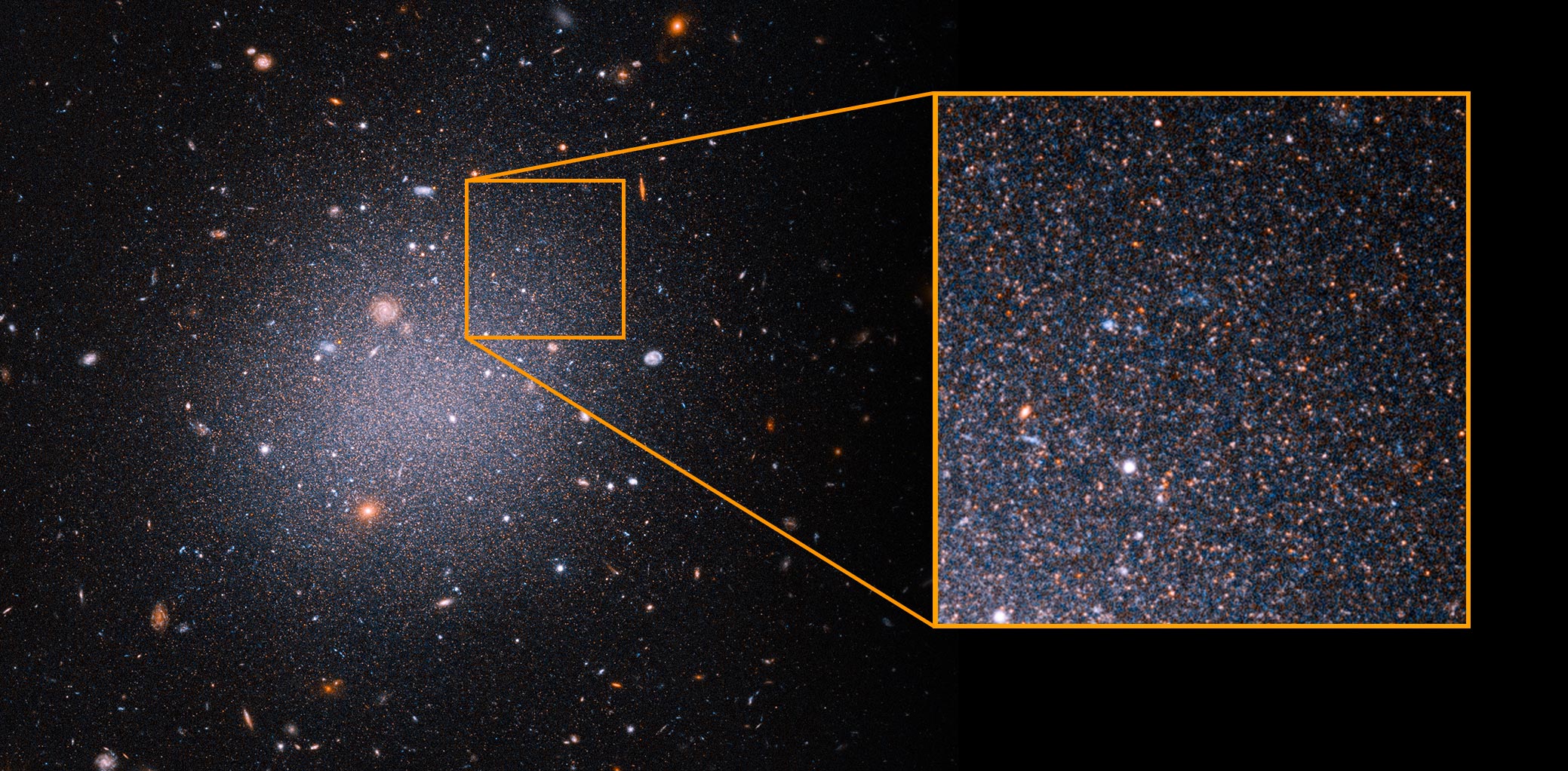
They say the distance measurement solidifies their claim that DF2 lacks dark matter, the invisible glue that makes up the bulk of the universe’s contents.
The galaxy contains at most 1/400th the amount of dark matter that the astronomers had expected?
But the bulk of a galaxy’s makeup is in dark matter, the invisible glue that keeps a lid on stars, so they don’t escape from the galaxy.
After all, the entire cosmos is built on the invisible scaffolding of dark matter.
If DF2 were closer than they thought, the dark matter mystery goes away.
The researchers say the new milepost helps them confirm that dark matter is really missing in the galactic oddball.
When astronomers using NASA’s Hubble Space Telescope uncovered an oddball galaxy that looks like it doesn’t have much dark matter, some thought the finding was hard to believe and looked for a simpler explanation.
Dark matter, after all, is the invisible glue that makes up the bulk of the universe’s contents.
So, finding a galaxy lacking the invisible stuff is an extraordinary claim that challenges conventional wisdom.
When astronomers using NASA’s Hubble Space Telescope uncovered an oddball galaxy that looked like it didn’t have much dark matter, some thought the finding was hard to believe and looked for a simpler explanation.So, finding a galaxy lacking the invisible stuff is an extraordinary claim that challenges conventional wisdom.To bolster their original finding, first reported in 2018 (Dark Matter Goes Missing in Oddball Galaxy), a team of scientists led by Pieter van Dokkum of Yale University in New Haven, Connecticut, followed up their initial study with a more robust Hubble look at the galaxy, named NGC 1052-DF2.The researchers found that the observed number of stars accounts for the galaxy’s total mass, and there’s not much room left for dark matter.
The galaxy, therefore, would need dark matter to account for the observed effects of the total mass.
This Hubble Space Telescope image offers a sampling of aging, red stars in the ultra-diffuse galaxy NGC 1052-DF2, or DF2.The galaxy continues to puzzle astronomers because it is lacking dark matter, an invisible form of matter that provides the gravitational glue to hold galaxies together.
The close-up at right reveals the many aging red giant stars on the outskirts of the galaxy that are used as intergalactic milepost markers.
The galaxy contains at most 1/400th the amount of dark matter that the astronomers had expected, based on theory and observations of many other galaxies.
Called an ultra-diffuse galaxy, the galactic oddball is almost as wide as the Milky Way, but it contains only 1/200th the number of stars as our galaxy.
The ghostly galaxy doesn’t appear to have a noticeable central region, spiral arms, or a disk.
The research team based its new result on long exposures with Hubble’s Advanced Camera for Surveys, which provide a deeper view of the galaxy for finding a reliable yardstick to nail down the distance.The more accurate Hubble measurements solidify the researchers’ initial conclusion of a galaxy deficient in dark matter, team members say.Called an ultra-diffuse galaxy, this galactic oddball is almost as wide as the Milky Way, but it contains only 1/200th the number of stars as our galaxy.
The galactic oddball is almost as wide as the Milky Way, but it contains only 1/200th the number of stars as our galaxy.
The team estimates that DF2 contains at most 1/400th the amount of dark matter than astronomers had expected.
DF2 isn’t the only galaxy devoid of dark matter.Shany Danieli of the Institute for Advanced Study in Princeton, New Jersey, used Hubble in 2020 to obtain an accurate distance to another ghostly galaxy, called NGC 1052-DF4 (or simply DF4), which apparently lacks dark matter, too.
In this case, however, some scientists suggest the dark matter may have been stripped out of the galaxy due to tidal forces from another galaxy.
In 2020, a group of researchers uncovered 19 unusual dwarf galaxies they say are deficient in dark matter (Off the Baryonic Tully–Fisher Relation: A Population of Baryon-dominated Ultra-diffuse Galaxies – IOPscience ).
Nevertheless, van Dokkum thinks finding a galaxy lacking dark matter tells astronomers something about the invisible substance.“In our 2018 paper, we suggested that if you have a galaxy without dark matter, and other similar galaxies seem to have it, that means that dark matter is actually real and it exists,” van Dokkum said.
Reference: “A Tip of the Red Giant Branch Distance of 22.1 ± 1.2 Mpc to the Dark Matter Deficient Galaxy NGC 1052–DF2 from 40 Orbits of Hubble Space Telescope Imaging” by Zili Shen, Shany Danieli, Pieter van Dokkum, Roberto Abraham, Jean P.We have seen examples of a black hole being ejected from a galaxy so it is not that big a stretch to imagine both black holes being slingshotted out and taking most of the dark matter with them